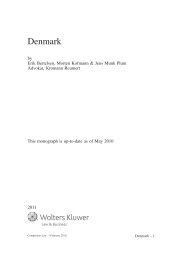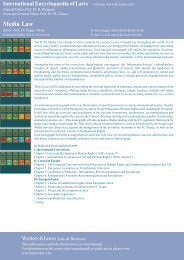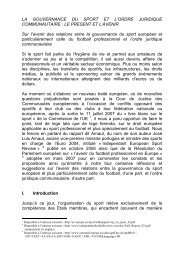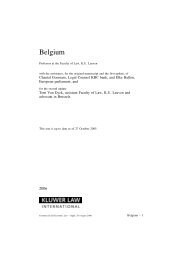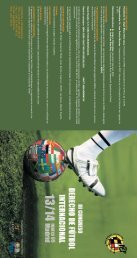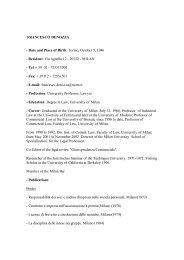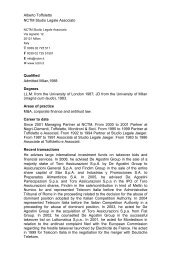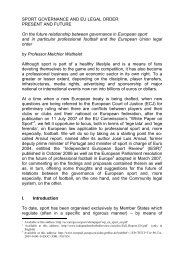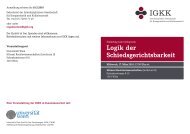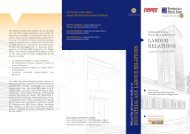56–57 Part I, Ch. 1, Constitutional Formation and Design§3. NATIONAL NON-MANDATORY GUIDELINES FOR CONTENT OF STATECONSTITUTIONS56. National non-mandatory guidelines have had their greatest influenceon state constitutions via constitutional interpretation. As a matter <strong>of</strong> law, statesupreme courts are the authoritative interpreters <strong>of</strong> state constitutions. Nevertheless,state constitutional interpretation has long been influenced by federalinterpretation, particularly in the realm <strong>of</strong> civil liberties. This has occurred evenwhen the texts <strong>of</strong> the state and federal guarantees have been quite dissimilar.Prior to the 1970s, attorneys and state judges <strong>of</strong>tentimes assumed that state andfederal rights guarantees should be interpreted as affording equivalentprotections. Even though the interest <strong>of</strong> state courts in state constitutions hasincreased in recent decades (a phenomenon known as the ‘new judicialfederalism’), state judges continue to employ the categories and conceptions <strong>of</strong>federal constitutional law in the interpretation <strong>of</strong> state rights guarantees. Indeed,in some instances states have incorporated the concepts and rulings <strong>of</strong> federaldecisional law directly into their constitutions. California has outlawed the use<strong>of</strong> busing for racial integration <strong>of</strong> public schools beyond that required to remedyviolations <strong>of</strong> the equal protection clause <strong>of</strong> the federal Constitution. 1 Florida hasrequired that its search-and-seizure provision ‘be construed in conformity withthe Fourth Amendment to the United States Constitution, as interpreted by theUnited States Supreme Court.’ 2 And Hawaii by amendment constitutionalizedthe U.S. Supreme Court’s ruling in Gideon v. Wainwright requiring governmentalprovision <strong>of</strong> counsel to indigent defendants in criminal cases. 31. California Constitution, Article I, section 7.2. Florida Constitution, Article I, section 12.3. Hawaii Constitution, Article I, section 14, constitutionalizing the U.S. Supreme Court’sruling in Gideon v. Wainwright, 372 U.S. 335 (1963).57. There is also a sense in which the contents <strong>of</strong> the U.S. Constitutionhave an influence on the contents <strong>of</strong> state constitutions. Scholars have describedthe U.S. Constitution as an ‘incomplete constitution,’ in the sense that ‘asignificant number <strong>of</strong> questions we can bring to it are not answerable using theone document alone.’ 1 This means that to understand the foundations <strong>of</strong>American government, one must look beyond the U.S. Constitution to otherdocuments, including the state constitutions. Thus ins<strong>of</strong>ar as the nationalconstitution leaves certain questions unresolved, there is an impetus to stateconstitutions to provide answers to those constitutional questions. Someexamples may serve to clarify the point. Instead <strong>of</strong> setting eligibility requirementsfor voting, the U.S. Constitution initially left that determination to thestates, and thus state constitutions addressed the issue. Similarly, the U.S.Constitution does not address the subject <strong>of</strong> education, and thus state constitutionsare obliged to treat it at length.1. Donald S. Lutz, ‘The United States Constitution as an Incompetent Text,’ Annals <strong>of</strong> theAmerican Academy <strong>of</strong> Political and Social Science, 496 (March 1988): 32.28 – <strong>USA</strong> (Sub-national) Constitutional Law – Suppl. 34 (October 1999)
Constitutional Formation and Design, Part I, Ch. 1 58–5958. Federal constitutional amendments affecting voting and apportionmenthave also had a pronounced effect on state constitutions. The federal Constitutionoriginally left voting qualifications and apportionment to the states. Thefederalization <strong>of</strong> voting law began with the adoption <strong>of</strong> the Fifteenth Amendment,requiring that states not discriminate in their voting qualifications on thebasis <strong>of</strong> race, and continued with the adoption <strong>of</strong> the Nineteenth Amendment(women’s suffrage), the Twenty-Fourth Amendment (poll tax), and the Twenty-Sixth Amendment (eighteen-year-old vote). These amendments imposed uniformnational standards for voting, removing a major source <strong>of</strong> constitutionalcontroversy from state control. Many states subsequently brought their constitutionsinto conformity with the federal requirements, either deleting inconsistentprovisions or adopting amendments analogous to the federal amendments.Beginning in the 1960s, the Fourteenth Amendment spawned successfulchallenges to state systems <strong>of</strong> legislative apportionment and to state regulations<strong>of</strong> voting, such as poll taxes and residency requirements. 1 Congress also enactedthe Voting Rights Act <strong>of</strong> 1965, and this act – together with its 1982 amendments– dramatically expanded and intensified federal supervision over stateelectoral laws and practices. Yet these federal interventions have not altogetherprecluded an independent state role. For example, many state constitutionsrequire that local boundaries be respected in districting decisions, and stateapportionment commissions and state courts have continued to enforce thatrequirement, ins<strong>of</strong>ar as it can be reconciled with the federal ‘one person, onevote’ standard. 21. See, e.g. Harper v. Virginia State Board <strong>of</strong> Elections, 383 U.S. 663 (1966), and Dunn v.Blumstein, 405 U.S. 330 (1972).2. See, e.g., Fischer v. State Bd. <strong>of</strong> Elections, 879 S.W.2d 475 (Ky. 1994); Fonfara v.Reapportionment Commission, 610 A.2d 153 (Conn. 1992).59. Finally, Congress, acting through its spending power, may reach manysubjects normally reserved to the states, although it does so indirectly. It mayaccomplish its aims indirectly by attaching conditions to federal spendingprograms or grants. State constitutions may make state compliance with suchconditions difficult. For example, Congress required that states enact ‘certificate<strong>of</strong> need’ legislation as a condition for the receipt <strong>of</strong> federal health planning funds.Prior to this requirement, the North Carolina Supreme Court had ruled that state‘certificate <strong>of</strong> need’ legislation was unconstitutional as granting special privilegesand monopolies in violation <strong>of</strong> the North Carolina Constitution. 1 North Carolinatherefore argued that the congressional requirement interfered with state sovereignty.A federal district court rejected this argument. 2 This decision left NorthCarolina with the choice <strong>of</strong> foregoing the federal funds, amending its constitution,or seeking a different interpretation from its supreme court. Nevertheless, Congressmay sometimes choose not to impose conditions in federal grant programs thatrequire a state to do something that its constitution prohibits. 31. In re Certificate <strong>of</strong> Need for Aston Park Hospital, Inc., 193 S.E.2d 729, 736 (N.C. 1973).2. North Carolina ex rel. Morrow v. Califano, 445 F. Supp. 532, 535–536 (E.D.N.C. 1977),aff’d. mem., 435 U.S. 962 (1978).3. Wheeler v. Barrera, 417 U.S. 402, 416–419 (1974) (‘Whatever the case might be if therewere no expression <strong>of</strong> specific congressional intent, Title I evinces a clear intention that stateConstitutional Law – Suppl. 34 (October 1999) <strong>USA</strong> (Sub-national) – 29
- Page 1 and 2: United States of AmericaSub-nationa
- Page 3 and 4: The AuthorsG. Alan Tarr is Distingu
- Page 5 and 6: Table of ContentsThe Authors 3Gener
- Page 7 and 8: Table of Contents§ 2. Political Pa
- Page 9 and 10: General Introduction1§1. THE SUB-N
- Page 11 and 12: General Introduction 2-6§2. TYPES
- Page 14 and 15: 14-19 General Introductionofficials
- Page 16 and 17: 24-28 General Introductioning text
- Page 18 and 19: 36-39 General IntroductionOlder loc
- Page 20 and 21: General Introduction20 - USA (Sub-n
- Page 22 and 23: 43-47 Selected BibliographyRobert F
- Page 24 and 25: Selected Bibliography24 - USA (Sub-
- Page 26 and 27: 52-53 Part I, Ch. 1, Constitutional
- Page 30 and 31: 60-63 Part I, Ch. 1, Constitutional
- Page 32 and 33: 69-70 Part I, Ch. 1, Constitutional
- Page 34 and 35: 74-76 Part I, Ch. 1, Constitutional
- Page 36 and 37: 80-83 Part I, Ch. 1, Constitutional
- Page 38 and 39: 86 Part I, Ch. 1, Constitutional Fo
- Page 40 and 41: 125-127 Part II, Ch. 1, Generallegi
- Page 42 and 43: 129Chapter 2. Head of the Sub-natio
- Page 44 and 45: 135-138 Part II, Ch. 3, The Legisla
- Page 46 and 47: 143-145 Part II, Ch. 3, The Legisla
- Page 48 and 49: 150-153 Part II, Ch. 3, The Legisla
- Page 50 and 51: 185 Part III, Ch. 1, Sub-national C
- Page 52 and 53: 191-197 Part III, Ch. 2, Fundamenta
- Page 54 and 55: 203-205 Part III, Ch. 2, Fundamenta
- Page 56 and 57: 209-212Chapter 4. Judicial Control
- Page 58 and 59: Part III, Ch. 5, Legal Position of
- Page 60 and 61: 216-218Chapter 2. Constitutional St
- Page 62 and 63: 223-224 Part IV, Ch. 3, Evolution o
- Page 64 and 65: Illinois ConstitutionSection 5. Rig
- Page 66 and 67: Illinois ConstitutionSection 16. Ex
- Page 68 and 69: Illinois ConstitutionArticle IV - T
- Page 70 and 71: Illinois Constitutionmembers electe
- Page 72: Illinois ConstitutionSection 12. Le
- Page 75 and 76: Illinois ConstitutionSection 16. Se
- Page 77 and 78: Illinois ConstitutionSection 8. Ass
- Page 79 and 80:
Illinois Constitution(e)(f)(g)are J
- Page 81 and 82:
Illinois Constitution(d)(e)treasure
- Page 83 and 84:
Illinois Constitutiongovernmental s
- Page 85 and 86:
Illinois ConstitutionSection 2. Non
- Page 87 and 88:
Illinois Constitution(c)(d)(e)(f)gu
- Page 89 and 90:
Illinois Constitutioncandidates for
- Page 91 and 92:
Illinois Constitutionfiled with the
- Page 93 and 94:
IndexThe numbers given are paragrap



